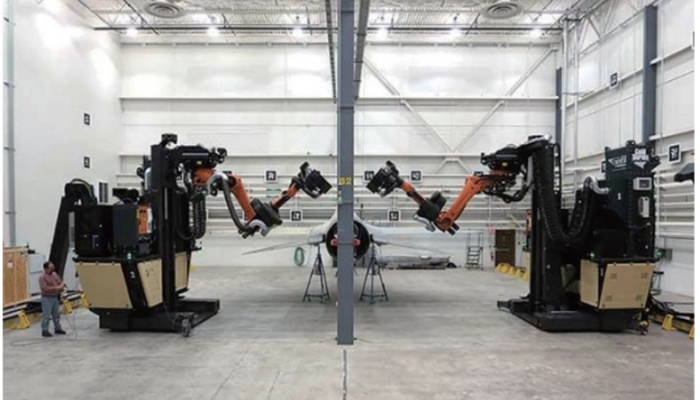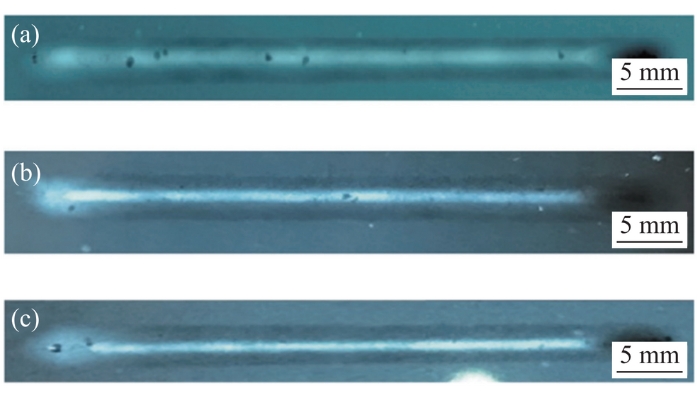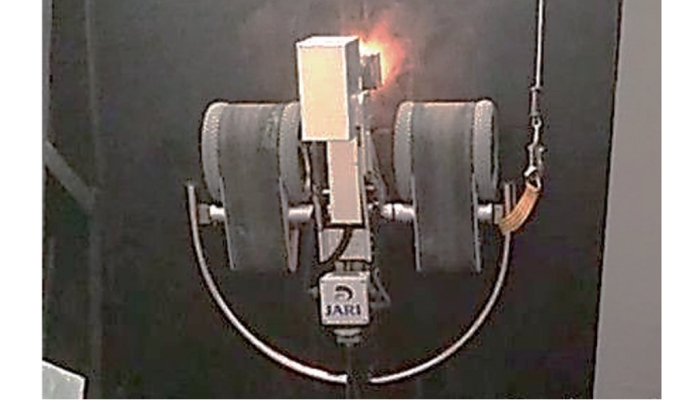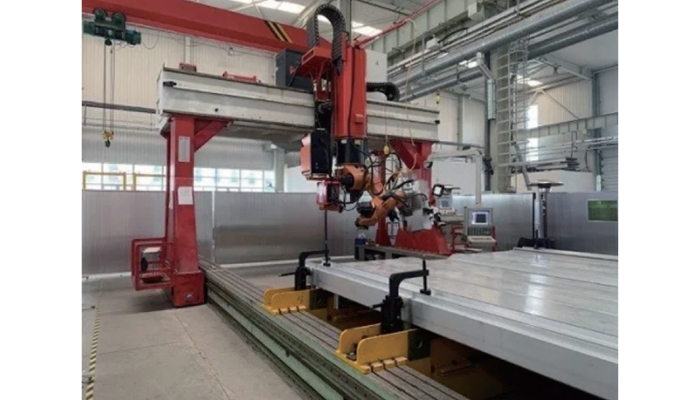After years of development, the industrial application of pulse laser cleaning technology has covered many fields such as aerospace, marine vessels, rail transportation, etc. The cleaning objects include paint, rust, oil, resin, oxides and so on. The following will introduce the pulse laser cleaning machines in some typical areas of research and application progress.
1. Aerospace Field
1.1 Aircraft skin paint removal
After an aircraft has been in service for a period of time, the paint on the surface of the skin will be peeling off, aging, cracking and other phenomena. In the overhaul process, the original paint layer needs to be removed and repainted to avoid fatigue accidents.In 2015, Concurrent Technologies and the U.S. Robotics Engineering Center jointly developed the Robotic Laser Coating Removal System (ARLCRS), which completed the paint removal operations on the surfaces of the F-16 fighter jet and the C130 transport aircraft by equipping the robot with an IPG fiber laser source. As shown in Figure 1, the system doubled the paint removal efficiency compared to previous paint removal methods.

Figure.4 Laser cleaning composite welding automatic robot
The Netherlands XYREC company developed a large laser coating removal robot (LCR), and is equipped with a high-speed machine vision system and a 20 kW CO2 laser. 2021, the LCR on the B727 airliner paint removal test, the results show that the LCR with 44 m ² / h to achieve the effective removal of paint, during the process of the substrate temperature can be maintained at 80 ℃ or less.
Our scholars have also conducted a lot of experimental research on laser paint removal for aircraft skin, and by choosing the right combination of scanning speed and pulse frequency, the paint removal efficiency can be effectively improved without causing damage to the substrate. By analyzing the particulate matter generated during cleaning, three stripping mechanisms are proposed: laser ablation, thermal stress vibration and plasma impact. In the laser energy density of 5 J/cm², the skin surface composite paint layer can be completely removed, paint removal after the substrate surface micro-hardness and corrosion resistance improved, but the laser impact on the surface produced a certain degree of plastic deformation, which is the engineering application of the problem to be noted.
1.2 Aeronautical structural parts processing
Carbon fiber composite materials (CFRP) with high strength, fatigue resistance and other characteristics, the use of the overall material in the aircraft is gradually increasing. In order to improve the bonding strength of CFRP, it is necessary to remove the epoxy resin and impurities on the surface of the material beforehand. Nanosecond pulse laser cleaning experiments on the CFRP surface yielded a better cleaning effect at a laser power density of 8.8 kW/cm² and a scanning speed of 1000 mm/s, and the shear strength and bending strength of the material were improved after laser cleaning.
Titanium alloys are commonly used as structural components in aerospace manufacturing due to their lightweight, high strength, and corrosion-resistant properties. The removal mechanism of the oxide film on the surface of titanium alloy was investigated using a nanosecond pulsed laser. With the increase of laser fluence, the surface roughness and oxygen content of the material decreased and then increased, and when the energy density reached 3.98 J/cm², the oxide film was fully removed, in which the ablation effect was the main mechanism of laser removal. Suitable laser cleaning in the improvement of surface roughness of titanium alloy at the same time, the laser welding of metallurgical type, process-type porosity are inhibited, Figure 2 shows the laser cleaning pre-treatment of the weld to meet the Chinese aerospace industry industry I class weld requirements.

Figure.2 X ray images of welded sample after different pretreatment. (a) Pickling; (b) Sandpaper polishing; (c) Laser cleaning
2.Shipbuilding Field
2.1 Above water laser cleaning applications
In the ship repair process there are a large number of cleaning links, mainly including the hull and cabin overall rust removal and paint removal. National University of Singapore used 500 W fiber pulsed laser on the ship cabin rust, grease and other pollutants for cleaning experiments,pulse laser cleaning of the hull surface rust removal grade reached the IOS surface treatment standard Sa2.5. Kim et al. used an average power of 100 W tuned Q fiber laser on the surface of the marine steel oxidation layer and primer for laser experiments, the study concludes that when the laser energy density for the 10.5 J/cm², spot overlap rate of 20%, obtained a good cleaning quality, surface roughness to meet the requirements of the secondary spraying.
Adapt Laser’s product CL600 was approved for Navy use, which utilizes a 600 W semiconductor-pumped solid-state laser and supports dual modes of operation, hand-held piggyback, and robotic arm.In October 2022, Laser Photonics released the MARLIN series of air-cooled, pulsed laser cleaning machine systems, whose portable design is ideally suited for the removing marine corrosion from the surface of welded joints on ship frames.
Lei Zhenglong et al. used dry and wet laser cleaning methods to remove rust from high carbon steel respectively, and found that both methods can effectively remove surface corrosion at high power, while wet laser cleaning process is more effective at low power conditions. The China Shipbuilding Research Institute (CSRI) has successfully developed a pulse laser cleaning wall-climbing robot, as shown in Figure. 3. The robot is equipped with a 2,000 W fully pulsed laser cleaning machine, is light and flexible, and can run smoothly on the outer wall of the side. The initial descaling experiments carried out in Wuchang Shipbuilding Company show that the descaling efficiency of the equipment can reach 180 m²/h, and the surface of the cleaned steel plate meets the quality requirements of the PSPC, and there is no dust emission in the descaling process.

Figure.3 Wall-climbing robot for laser cleaning
2.2 Underwater laser cleaning application
The hull structure located below the water surface is corroded by seawater and microorganisms, and a layer of biofilm will be formed on the surface, which will cause marine organisms to gather, and ultimately lead to increased resistance, thus reducing the speed of ship navigation. Currently, the use of cleaning brush and air jet underwater intelligent cleaning equipment has been gradually improved, but the nature of its traditional cleaning leads to cleaning quality is difficult to ensure, through the combination of underwater robotics and intelligent pulse laser cleaning equipment or will become the mainstream of underwater ship cleaning.
Zimbelmann et al. through the laser underwater non-contact cleaning experiments show that the short wavelength laser is more suitable for removing marine microbial contamination on the surface of the coating. lu et al. used nanosecond ultraviolet laser on the surface of marine steel microbial fouling cleaning experiments, resulting in the initial cleaning threshold and the complete cleaning threshold of 2.75 J/cm² and 5.3 J/cm², respectively, the surface of the substrate after pulse laser cleaning, corrosion resistance increased by 3 times. The corrosion resistance of the surface of the substrate after pulsed laser cleaning was improved by 3 times, and its research content provides process support for underwater laser cleaning.
Russia’s Far Eastern Federal University has developed a remotely operated unmanned vehicle (ROV) that successfully removes corrosion from sheet metal surfaces underwater with a built-in pulse laser cleaning machine system, although its actual cleaning efficiency has yet to be further tested. Laser Center Hannover, Germany, announced that it is developing an underwater pulse laser cleaning robot for the cleaning of marine organisms and dirt on the side and bottom plates of ships, which is expected to solve the problems of low efficiency of mechanical cleaning and safety hazards of manual polishing.
3.Railway Transportation Field
3.1 Aluminum alloy oxide film removal
Aluminum alloy in rail vehicles need to remove the surface oil and oxide film before welding, commonly used pre-welding treatment methods such as mechanical grinding and chemical cleaning there are poor cleaning quality, low efficiency and other defects. The effect of laser energy density on the removal of oxide film on the surface of aluminum alloy of rail vehicles was investigated, and it was concluded that when the energy density was 1.82 J/cm², the oxygen content could be reduced to 2.03% without melting of the substrate, and the surface hardness of the substrate was slightly improved after laser cleaning process, in which gasification and plasma impact were the main mechanisms for the removal of oxide film.
In 2020, China CNR Qingdao Sifang Locomotive and Rolling Stock Co., Ltd. developed the automated cleaning technology for aluminum alloy body parts, which realizes the integrated and efficient operation of pulse laser cleaning and welding by integrating the pulse laser cleaning machine with a gantry-type laser arc welding robot [35], see Figure. 4. At present, this technology has been realized in the engineering application of the high-speed magnetic levitation train project.

Figure.4 Laser cleaning composite welding automatic robot[35].
In addition, LASERSONLY and MOZLASER have also launched the integrated laser cutting, cleaning and welding equipment, which can remove oil, rust and other pollutants on the surface of the substrate before welding, and remove the oxides and black ash on the surface after welding, and at the same time carry out the cutting of plates, avoiding a series of problems such as high cost and cumbersome work procedures when using multiple processing equipment.
3.2 High-speed railroad rolling stock wheelset cleaning
China Railway First Survey and Design Institute Group Co., Ltd. has developed a wheel pair automatic pulse laser cleaning machine system based on machine vision bit technology, which effectively solves the positioning problem under the cleaning scene by extracting the image of wheel rim and then sequentially matching, reconstructing and positioning, and realizes intelligent and perceptive application. 2022, Hangzhou Metro has carried out a composite pulse laser cleaning process for the wheel pairs of the metro based on the synergistic system of the three-axis servo and the rotating wheel mechanism by adopting the helix line cleaning method which resulted in specific process parameters suitable for wheel pair cleaning, and the cleaned surface met the requirements of the flaw detection process.
4.Conclusion:
According to the aerospace, shipbuilding and rail transportation in three areas of research and application progress can be seen, in recent years, world wide’s research on pulse laser cleaning technology in the cleaning mechanism, process and other aspects of the great progress, some independent research and development of equipment has been applied to industrial production. However, compared with foreign countries, many areas of research still remain in the laboratory stage, due to high-power short-pulse lasers and high-speed scanning mirrors and other core technologies are monopolized by foreign countries, hindering the development of efficient pulse laser cleaning machines, existing equipment in the face of some of the large-area stubborn pollutants, it is difficult to meet the double requirements of cleaning quality and cleaning efficiency. In addition, the stability and flexibility of the cleaning equipment to be further improved to adapt to a more complex operating environment.


